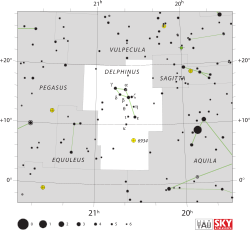Delphinus
| Constellation | |

|
|
| Abbreviation | Del |
|---|---|
| Genitive | Delphini |
| Pronunciation | /dɛlˈfaɪnəs/ Delfínus, genitive /dɛlˈfaɪnaɪ/ |
| Symbolism | (dolphin) |
| Right ascension | 21 |
| Declination | +10 |
| Family | Heavenly Waters |
| Quadrant | NQ4 |
| Area | 189 sq. deg. (69th) |
| Main stars | 5 |
|
Bayer/Flamsteed stars |
19 |
| Stars with planets | 5 |
| Stars brighter than 3.00m | 0 |
| Stars within 10.00 pc (32.62 ly) | 2 |
| Brightest star | Rotanev (β Del) (3.63m) |
| Nearest star |
HU Del (29.01 ly, 8.89 pc) |
| Messier objects | 0 |
| Meteor showers | None |
| Bordering constellations |
Vulpecula Sagitta Aquila Aquarius Equuleus Pegasus |
|
Visible at latitudes between +90° and −70°. Best visible at 21:00 (9 p.m.) during the month of September. |
|
Delphinus /dɛlˈfaɪnəs/ is a constellation in the northern sky, close to the celestial equator. Its name is Latin for dolphin. Delphinus was one of the 48 constellations listed by the 2nd century astronomer Ptolemy, and it remains among the 88 modern constellations recognized by the International Astronomical Union. It is one of the smaller constellations, ranked 69th in size.
Delphinus' brightest stars form a distinctive asterism that can easily be recognized. It is bordered (clockwise from north) by Vulpecula the fox, Sagitta the arrow, Aquila the eagle, Aquarius the water-carrier, Equuleus the foal and Pegasus the flying horse.
Delphinus does not have any bright stars; its brightest star is of magnitude 3.8. The main asterism in Delphinus is Job's Coffin, formed from the four brightest stars: Alpha, Beta, Gamma, and Delta Delphini. Alpha and Beta Delphini are named Sualocin and Rotanev, respectively. When read backwards, they read as Nicolaus Venator, the Latinized name of Palermo Observatory's former director, Niccolò Cacciatore. However, Delphinus is in a rich Milky Way star field.
...
Wikipedia
